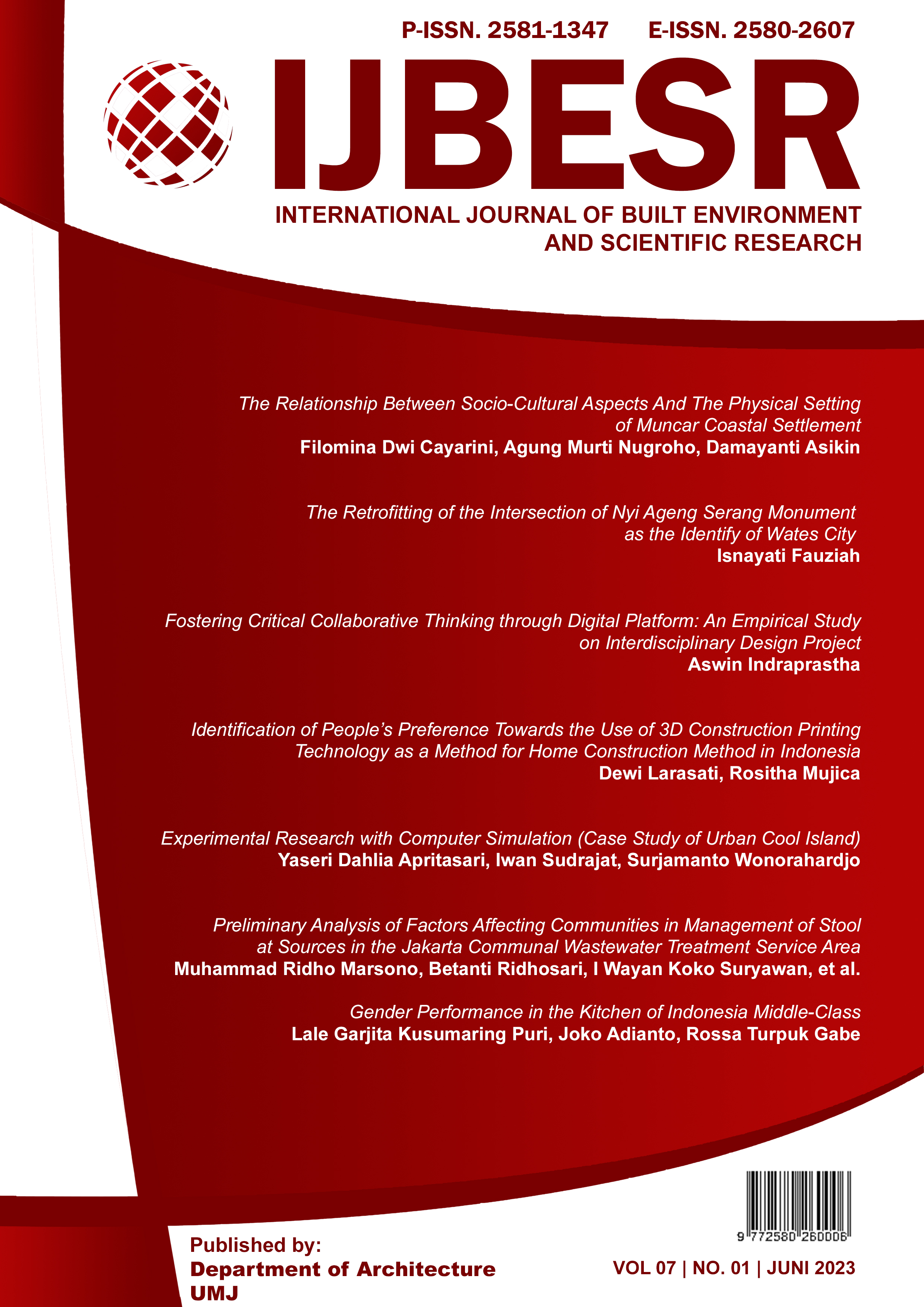Gender Performance in the Kitchen of Indonesian Middle-Class
DOI:
https://doi.org/10.24853/ijbesr.7.1.61-74Keywords:
Gender, Gender Performativity, Middle-Class, Domestic Activity, KitchenAbstract
This paper explores gender performance in Indonesia's middle-class’ kitchen. Gender mainstreaming and gender responsiveness have been on the Indonesian national development agenda since 2000, especially in vertical housing. However, gaps in the publication of the policy's implementation indicate the need for a basic understanding of gender to specify what should be accommodated to fulfil the agenda. Moreover, in previous studies, gender in Indonesia has not been discussed in the context of gender relations within the household. This research answers the question regarding the performance of daily activities that took place in the kitchen based on the actors’ gender. The performativity is influenced by the fulfilment of their preferences based on their household type; consisting of individual, traditional, and non-traditional household types. Each household has its own type of kitchen that will maintain the performativity of the gender.References
Laucereno SF. Harga Rumah Mahal, Sri Mulyani Sebut Masyarakat Pilih Tinggal dengan Mertua. detikfinance. Published July 6, 2022. Accessed August 20, 2022. https://finance.detik.com/properti/d-6164638/harga-rumah-mahal-sri-mulyani-sebut-masyarakat-pilih-tinggal-dengan-mertua
Laucereno SF. Harga Rumah Mahal dan Bunga Tinggi Ancam Milenial RI Jadi “Gelandangan.” detikfinance. Published July 9, 2022. Accessed August 20, 2022. https://finance.detik.com/properti/d-6164638/harga-rumah-mahal-sri-mulyani-sebut-masyarakat-pilih-tinggal-dengan-mertua
Direktorat Jenderal Penyediaan Perumahan Kementerian PUPR. Laporan Kinerja Direktorat Rumah Susun; 2020. https://perumahan.pu.go.id/rusun/article/139/laporan-kinerja
Pink S. Home Truths: Gender, Domestic Objects and Everyday Life. Berg; 2004.
Cieraad I. “Out of my kitchen!” Architecture, gender and domestic efficiency. The Journal of Architecture. 2002;7(3):263-279. doi:https://doi.org/10.1080/13602360210155456
Butler J. Undoing Gender. Routledge; 2004.
Pink S, Mackley KL, MoroŞanu R, Mitchell V, Bhamra T. Making Homes Ethnography and Design. Bloomsbury Academic; 2017.
Germon J. Gender: A Genealogy of an Idea. Palgrave Macmillan; 2009.
Blackburn S. Women and the State in Modern Indonesia. Cambridge University Press; 2009.
Ananta A. Employment Patterns of Older Women in Indonesia. In: Gender and Ageing: Southeast Asian Perspectives. Institute Of Southeast Asian Studies; 2014.
Robinson K. Women in Indonesia: Gender, Equity and Development. Iseas; 2002.
Cano, M. (2019). Masculinity in the Kitchen: Gender Performance in the Culinary Arts Industry (Order No. 13886662). Available from ProQuest Dissertations & Theses Global. (2272298555). https://www.proquest.com/dissertations-theses/masculinity-kitchen-gender-performance-culinary/docview/2272298555/se-2?accountid=17242
Llewellyn M. Designed by women and designing women: gender, planning and the geographies of the kitchen in Britain 1917-1946. cultural geographies. 2004;11(1):42-60. doi:https://doi.org/10.1191/1474474003eu292oa
Charlotte, De Backer JS. Grandma’s kitchen. An evolutionary perspective on gender differences in meal preparations. Appetite. 2011;56(2):525. doi:https://doi.org/10.1016/j.appet.2010.11.185
Ju SR. Southeast Asian Houses: Expanding Tradition. Seoul Selection; 2017.
Nas P. The House in Indonesia: Between Globalization and Localization. Bijdragen tot de Taal-, Land- en Volkenkunde. 1998;154(2):335-360. Accessed May 24, 2022. https://www.jstor.org/stable/27865433
Analisa FCK, Okada S. Tiny house characteristics in Indonesia based on millennial’s user preference. Urban, Planning and Transport Research. 2023;11(1). doi:https://doi.org/10.1080/21650020.2023.2166095
Boediono L. Aspiring Indonesia — Expanding the Middle Class. World Bank Group; 2017. Accessed December 22, 2021. https://www.worldbank.org/in/country/indonesia/publication/aspiring-indonesia-expanding-the-middle-class
Afif S. The Rising of Middle Class in Indonesia: Opportunity and Challenge. ’ University of Southern California, USA. http://www.umdcipe.org/conferences/DecliningMiddleClassesSpain/Papers/Afif.pdf
Lan TJ. Politics of Difference: Ethnicity and Social Class Within The Indonesian Middle Class in Digital Era. Antropologi Indonesia. 2020;41(1). doi:https://doi.org/10.7454/ai.v41i1.12659
Houle J, Coulombe S, Radziszewski S, et al. Public housing tenants’ perspective on residential environment and positive well-being: An empowerment-basedPhotovoicestudy and its implications for social work. Journal of Social Work. 2016;18(6):703-731. doi:https://doi.org/10.1177/1468017316679906
Frey W. The Millennial Generation: A demographic bridge to America’s diverse future. Published 2018. https://www.brookings.edu/wp-content/uploads/2018/01/2018-jan_brookings-metro_millennials-a-demographic-bridge-to-americas-diverse-future.pdf
Wang Q, Zhan HJ. The making of a home in a foreign land: understanding the process of home-making among immigrant Chinese elders in the U.S. Journal of Ethnic and Migration Studies. 2019;47(7):1539-1557. doi:https://doi.org/10.1080/1369183x.2019.1673706







